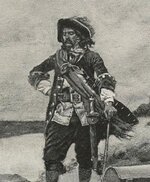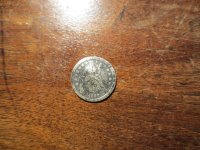gjb
Full Member
- Apr 21, 2016
- 240
- 307
- Detector(s) used
-
Garrett Ace 300i
Garrett EuroAce
- Primary Interest:
- All Treasure Hunting
Hi
I can rarely get anyone to take this seriously, but I believe there’s a distinct possibility that the ground markers on the island (the drilled rocks, the Welling and Mallon triangles, the ancient roadway, Nolan’s Cross, the Pirate Stones Triangle etc.) were positioned by survey according to a set plan. Furthermore, I believe that even given only the rough distances and relative positioning, and with the Roper Survey, it’s possible to reproduce this plan, because its purely geometrical in nature.
If this was done then there had to be a reason for the plan, and a reason the ground markers were placed where they are. Here’s where people generally lose interest. Given this, it’s possible to marry the reconstructed ground plan with the instructions on five (maybe six) of the so-called Kidd treasure maps. Just note that the instructions could be genuine though the maps themselves be copies of copies or transcriptions and composites.
The reconstructed geometry highlights an extended rhombus in the area covered by the drilled rocks and the Money Pit, and the instructions on the maps identify a pattern of regularly spaced points upon this when interpreted according to a simple set of rules:
1. Using the ground features as starting points - for the most part the drilled rocks and the Money Pit (Tree) - apply the instructions (on the first two lines) so as to define three points of a triangle. Then locate the centre of this triangle.
2. From this centre, take an offset using the concluding directions (the last line) which is in the form a + b + ac. Thus ‘3 feet by 3 feet by four' = 18 feet.
The pattern produced is a ‘W’ shape on the extended rhombus, but the significant point may be its centre.

I’ve published three books on the subject, including the truth about the origins and the discovery of the maps (Anthony Howlett’s account is inaccurate, as Hubert Palmer’s letters to Harold T. Wilkins, in my possession, demonstrate). A short note on this can be found at The Kidd Maps: The Reality.
A summary of the reconstructed ground plan and interpretation of the maps from my book can be found at Oak Island Treasure Map Hypothesis.
My research suggests that there were seven sets of instructions (thus, seven maps) of which five (maybe six) have come to light. I’ve dug up quite a bit of background on the origins of these maps, but the seventh map has eluded me.
I can rarely get anyone to take this seriously, but I believe there’s a distinct possibility that the ground markers on the island (the drilled rocks, the Welling and Mallon triangles, the ancient roadway, Nolan’s Cross, the Pirate Stones Triangle etc.) were positioned by survey according to a set plan. Furthermore, I believe that even given only the rough distances and relative positioning, and with the Roper Survey, it’s possible to reproduce this plan, because its purely geometrical in nature.
If this was done then there had to be a reason for the plan, and a reason the ground markers were placed where they are. Here’s where people generally lose interest. Given this, it’s possible to marry the reconstructed ground plan with the instructions on five (maybe six) of the so-called Kidd treasure maps. Just note that the instructions could be genuine though the maps themselves be copies of copies or transcriptions and composites.
The reconstructed geometry highlights an extended rhombus in the area covered by the drilled rocks and the Money Pit, and the instructions on the maps identify a pattern of regularly spaced points upon this when interpreted according to a simple set of rules:
1. Using the ground features as starting points - for the most part the drilled rocks and the Money Pit (Tree) - apply the instructions (on the first two lines) so as to define three points of a triangle. Then locate the centre of this triangle.
2. From this centre, take an offset using the concluding directions (the last line) which is in the form a + b + ac. Thus ‘3 feet by 3 feet by four' = 18 feet.
The pattern produced is a ‘W’ shape on the extended rhombus, but the significant point may be its centre.

I’ve published three books on the subject, including the truth about the origins and the discovery of the maps (Anthony Howlett’s account is inaccurate, as Hubert Palmer’s letters to Harold T. Wilkins, in my possession, demonstrate). A short note on this can be found at The Kidd Maps: The Reality.
A summary of the reconstructed ground plan and interpretation of the maps from my book can be found at Oak Island Treasure Map Hypothesis.
My research suggests that there were seven sets of instructions (thus, seven maps) of which five (maybe six) have come to light. I’ve dug up quite a bit of background on the origins of these maps, but the seventh map has eluded me.
Last edited:



 NP
NP





